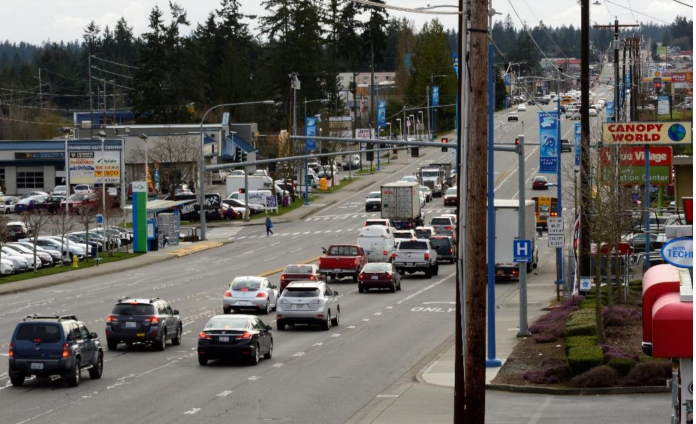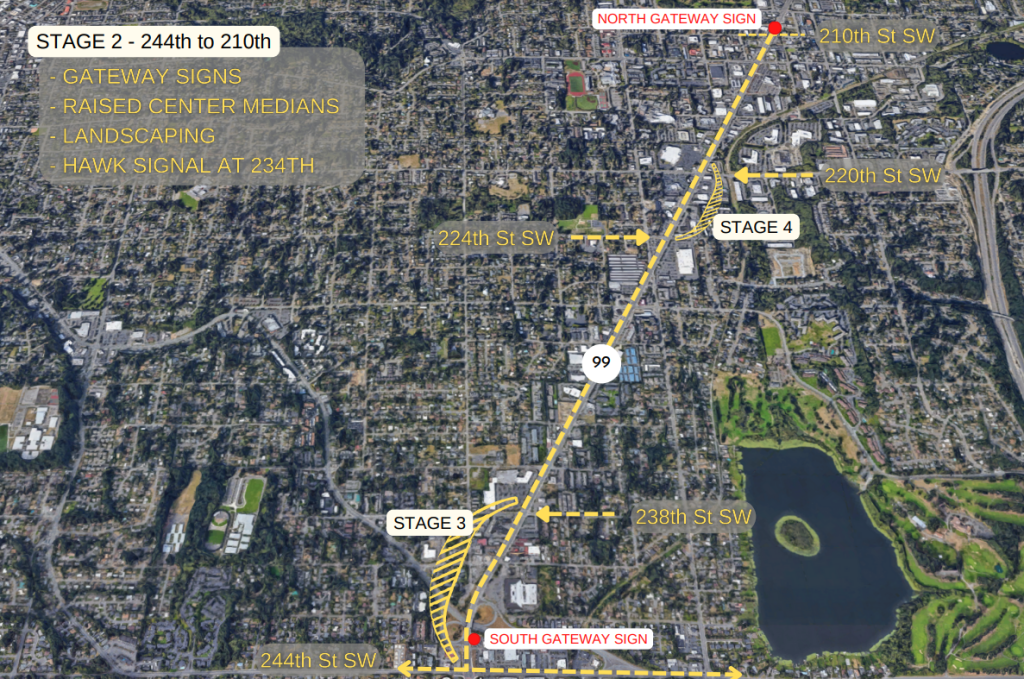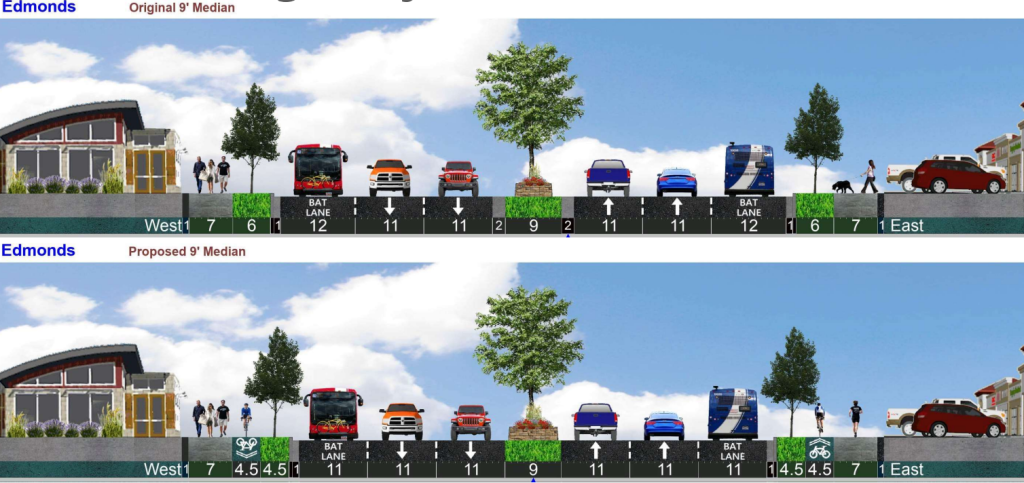
A protected bike lane along a state highway? It’s poised to become reality, thanks to a new state law upgrading the standards that the Washington State Department of Transportation (WSDOT) will use to coordinate adding bike and pedestrian facilities when basic maintenance is planned. The new Complete Streets mandate, signed into law with 2022’s Move Ahead Washington transportation package, could prove more impactful than many of the individual projects included in that multi-billion dollar transportation package. It has taken a bit of time to start to see what those results may be, but soon, a high profile project along one of the state’s busiest highways is set to become a clear illustration the mandate’s impacts.
Since 2017, the City of Edmonds has been working toward a full overhaul of State Route 99 within its borders, from 244th Street SW to 210th Street SW. Because the corridor revamp is being tackled in seven segments, different parts of the corridor are starting design at different times. Stages 1 and 2 have already started construction on raised medians, gateway signs, and other improvements. Stage 3 (244th to 238th Streets) and Stage 4 (224th to 220th Streets) were advanced into the design phase last year. The new segments, which amount to around twelve blocks in total, were prioritized over other parts of the corridor to improve traffic operations at major intersections.
Since the city’s design team had already developed concepts for segments 3 and 4 before their counterparts at WSDOT filled them in on what the new Complete Streets requirements entail, we can see the project change in real-time. It illustrates how many missed opportunities were left on the table prior to the legislature’s actions.
Any state highway projects over $500,000 in cost now require the state to evaluate whether gaps in both existing bicycle and pedestrian networks can be filled, and standards are required to be adhered to when it comes to separation between those facilities and automobile travel lanes.

Fulfilling the bike network on SR 99 in Edmonds requires a four-and-a-half-foot bike lane in each direction that does not appear in the original plans. The new proposed design adds the raised bike lane, protected by a planting strip, alongside the seven foot sidewalk along the highway. The real time changes we see to accommodate the extra nine feet of space required are planned buffers and planting strips narrowing and the 12-foot business access-and-transit (BAT) lanes shrinking by one foot each. Otherwise the six travel lanes along the highway are unaffected. Small changes that would have been left on the table.

During an Edmonds City Council meeting last week when an update on the design was provided, there was broad support for the change, which clearly doesn’t require a lot of sacrifices from other elements of the project. But there was also curiosity among some of the councilmembers present about the new requirement.
“WSDOT’s complete streets…this isn’t optional for us, is it? Does WSDOT require us to do complete streets?,” Councilmember Susan Paine asked following a presentation. Lisa Reed, the project manager with the City of Edmonds’ consultant on the project, confirmed that the city did had not opted into brand new standard. “To not incorporate it, you have to get what’s called a design deviation…which would probably be difficult to get for a project like this,” she said.
In this case, the design changes are fairly small, even as the benefits will be large. What remains to be seen is what happens when there are more direct trade-offs to adding Complete Streets elements, with a local plan calling for protected bike lanes but where there’s current local opposition to doing so — a state highway version of protected bike lanes on 35th Avenue NE.
A Significant Investment in Complete Streets
When lawmakers signed onto the Complete Streets mandate in the Move Ahead Washington package, one of the biggest questions was how much the requirement would impact the state transportation budget. Even as lawmakers plan to allocate hundreds of billions of dollars over the coming years toward expanding the state highway system, the state’s maintenance backlog on existing facilities continues to grow. While projects like the SR 99 revamp in Edmonds are funded by direct allocations from the legislature, most new bike or pedestrian facilities added by the Complete Streets mandate will need to come from the maintenance and preservation budget.
The 2022 update to WSDOT’s project delivery plan came up with a starting point for that estimate, stating that $750 million out of the $1.5 billion allocated in Move Ahead Washington would be anticipated to go to Complete Streets updates, a full half of the maintenance and preservation budget. That investment is likely the largest statewide expenditure on bicycle, pedestrian, and overall safe streets infrastructure in Washington history. Even that is not going to be enough to fill the estimated network gaps on state highways, around $5.3 billion dollars.
“I don’t like to view it as ‘what is the additional cost?’ because we know that building streets that aren’t complete is only leading to more fatalities, worse mobility. So I think it’s about ‘what do we need to do to build it right,” Senator Marko Liias, chair of the state senate’s transportation committee, said during a press conference on the proposed biennial state transportation budget last week — that budget starts to allocate funding for these projects, even though full costs are not yet known. “We need stormwater infrastructure, we need concrete that will last. We also need facilities for bicycles and pedestrians and these things aren’t additional cost as much as they are building it right.”
According to WSDOT Communications Manager Stefanie Randolph, the department has identified 44 individual projects in both fiscal year 2023 and fiscal year 2024 requiring Complete Streets review in either King or Snohomish County. With the 2023 projects, 24 were found to meet the requirements for potential upgrades, and 17 did not, with 3 projects still in review. For 2024, where reviews are in earlier stages, 17 projects were found to meet the requirements. Overall, approximately 2 out of every 3 projects were found to need upgrades.
In addition to SR 99 in Edmonds, Randolph noted that a repaving project impacting parts of State Route 527, through unincorporated Snohomish County and the city of Mill Creek, is just getting started and will be receiving a Complete Streets review. A repaving project impacting a portion of SR 203 in Monroe will be similarly assessed. There could be some big opportunities to connect population centers in Snohomish County in the coming years.

The new requirement has the potential to correct decades of oversights from local leaders and transportation officials when it comes to the bike and pedestrian networks on Washington’s state highways.
“When we build a state highway, it lasts for generations in that community. I can take you to a few places in my district where I wish they’d had complete streets 20 or 30 years ago, and we’d have better outcomes today,” Liias said. “When we talk about the next [statewide] transportation package, we’re going to need to make sure that our maintenance and preservation line items have additional funding to do these projects right.”
Ryan Packer has been writing for The Urbanist since 2015, and currently reports full-time as Contributing Editor. Their beats are transportation, land use, public space, traffic safety, and obscure community meetings. Packer has also reported for other regional outlets including BikePortland, Seattle Met, and PubliCola. They live in the Capitol Hill neighborhood of Seattle.



